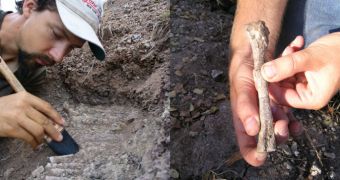According to a new scientific study, experts managed to discover the fossilized remains of dinosaur ancestors dating back to at least 243 million years ago. This new finding pushes back the date when the giant lizards developed by at least 10 million years, experts say. The ancestor discovered during the new digs goes by the name of Asilisaurus kongwe, and was a fairly small creature, roughly comparable in size to an average-sized dog. Paleontologists say that the shape of its teeth and jawbones seems to indicate that the animal was very well adapted to eating plants. It was most likely an herbivore, they add.
“This shows that the lineage leading to dinosaurs goes a lot further back in time than we thought. The second thing is that it shows that there’s this real ecological diversity. No one thought that the closest relatives to dinosaurs were these four-legged, herbivorous animals. We thought they were small carnivores,” explains study coauthor and paleontologist Randy Irmis. A paper detailing the findings was published in the March 3 issue of the esteemed scientific publication Nature. The remnants were unearthed from bare patches in Tanzanian grasslands. The sites yielded about 12 partial skeletons.
During the time of the Triassic period, this particular region was entirely covered with woodlands and fern-like plants, making it a warm, lush, and extremely dangerous place. The team behind the investigation says that primary analysis of the fossils would seem to indicate that the dinosaurs and the silesaurs diverge roughly 243 million years ago, which means that the giant lizards must have originated long before that. The silesaurs are a group that encompasses the genus Asilisaurus, Wired reports. But the scientists were really amazed to learn that the ancestor of dinosaurs were small herbivore animals, rather than the cat-sized two-legged predators initially considered.
“In a carnivorous animal, the teeth are pointed, or they are serrated, like a knife to cut meat. In order for this to be efficient, the serration has to be perpendicular to the edge of the tooth so that it functions like a knife. In these leaf-shaped teeth, you have some very vague serrations, but they are oriented towards the top of the teeth,” says Natural History Museum of Denmark paleontologist Gilles Cuny, who was not a part of the research. He explains that various types of dinosaurs evolved their own teeth, some similar to others, but absolutely independent from each other. This is another example of how a certain type of specialization is reached by several species, but through different evolutionary pathways.

 14 DAY TRIAL //
14 DAY TRIAL //